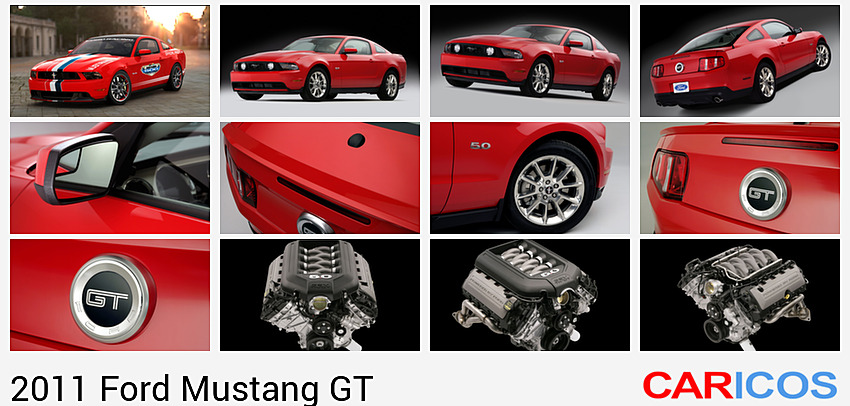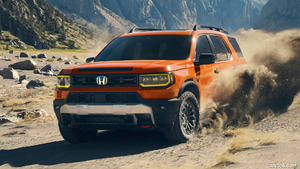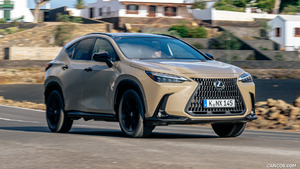2011 Mustang GT
Complementing those goals, a pair of new six-speed transmissions – one manual and one automatic – take advantage of the flexibility and fuel economy benefits of having six forward ratios, helping Mustang GT give powerful launches while also delivering relaxed cruising with exceptional fuel economy.
Chassis enhancements help improve the outstanding balance and driving behavior Mustang owners expect. Damper tuning and spring rates were revised to provide a smooth highway ride, while new rear lower control arms and firmer stabilizer bar bushings improve stiffness and handling for better cornering response over the highly praised 2010 model.
"The overall refinements to Mustang are really brought to life by its new engine," said David Pericak, Mustang chief nameplate engineer. "The car benefits from better handling, better braking and more refinement, and now it's powered by a high-tech 5.0-liter V-8 that Mustang enthusiasts and new customers alike are going to love."
Rebirth of the 5.0
The modern 5.0-liter four-valve Twin Independent Variable Camshaft Timing (Ti-VCT) V-8 engine in the new Mustang GT will deliver 412 horsepower and 390 ft.-lb. of torque. At the same time, fuel economy is projected to be better than the previous model and unsurpassed in the segment.
"This all-new 5.0-liter engine is the next chapter in the development of the world-class Mustang powertrain portfolio," said Derrick Kuzak, group vice president, Global Product Development. "It's a thoroughly modern engine for the times, delivering the performance and fun-to-drive factor that enthusiasts want, while improving fuel economy."
The six-speed automatic transmission in the 2011 Mustang GT will deliver fuel economy of 25 mpg highway and 18 city. This is up from 23 mpg highway and 17 city for the 2010 model. Six-speed manual transmission Mustang GT models for 2011 are projected to deliver 26 mpg highway and 17 city, matching the 2010 model but delivering significantly more horsepower and performance feel.
2011 Mustang GT fuel economy is enabled by Ti-VCT, the six-speed transmissions in automatic or manual variation, EPAS, additional tire spats and a rear decklid seal to enhance aerodynamics.
All-new aluminum four-valve-per-cylinder heads feature a compact roller-finger follower valvetrain layout leaving more room for high-flow ports for free-breathing performance. Head structure was designed to support higher cylinder head pressures and cross-flow cooling for sustained high-rpm use. Head bolt size was increased from 11 to 12 millimeters to contain the higher combustion pressures.
The aluminum block was developed for optimized windage and oil drainback under lateral conditions and high-rpm use, such as a track-day outing for an enthusiast owner or driver. Increased main bearing bulkhead widths and nodular iron cross-bolted main bearing caps with upsized bolts were also employed to accommodate the significant performance increase.
An additional element is the increased capacity and baffling of the deep-sump stamped steel oil pan to enable sustained high-rpm use and offer the convenience of 10,000-mile oil change intervals. Piston-cooling jets also were incorporated for performance-minded customers and for faster oil warm-up on cold start.
Specially designed tubular exhaust headers were developed to maximize exhaust pulse separation and improve flow. A team analyst actually fabricated the tubular headers in his home workshop, bringing the CAE design to life.
Engineers also made sure all their hard work wasn't disguised under the hood. Curved intake runners are framed by an acoustic cover sporting the new 5.0 logo, while "Powered by Ford" cam covers crown the tops of the cylinder banks. The effect is perfectly suited for a purpose-built performance machine like the new 5.0-liter V-8.
Transmission and powertrain improvements
Mustang GT drivers who prefer a manual gearbox will enjoy the short throws and direct feel of the shifter along with the relaxed cruising permitted by the extra top gear ratio.
Customers choosing the automatic will be pleasantly surprised to find the advanced six-speed transmission does not sacrifice fuel economy or performance – delivering crisp, quick shifts.
The automatic transmission also features a grade-assist or "hill mode" to improve drivability on hilly terrain. This technical innovation uses vehicle input – acceleration, pedal position, vehicle speed and brake status – to automatically determine the correct gear ratio while on an incline or decline. Hill mode eliminates sixth gear, extends lower gear operation on uphill climbs, and provides additional grade or engine braking for coast-downs.
The standard 3.31 (manual) and 3.15 (automatic) rear axle ratios provide an ideal blend of cruising fuel economy and acceleration, aided by the wide ratio spread permitted through the use of six forward speeds in the gearboxes. A standard limited-slip axle helps distribute the new engine's power between both rear wheels for maximum traction in all conditions.
A new era in Mustang driving dynamics
Electric Power Assist Steering has made a dramatic contribution to Mustang GT driving dynamics, delivering quicker on-center steering response, increased effort at highway speeds and reduced effort required in low-speed parking maneuvers. Because the belt-driven power steering pump is eliminated, EPAS provides a quieter vehicle with fewer components drawing engine power.
EPAS also enables new technologies that adjust for minor driving annoyances. Drift-Pull Compensation adjusts the steering to correct for crosswinds and minor road crowning, while Active Nibble Control helps eliminate the "shimmy" felt at high speeds when a wheel is out of balance or a brake rotor is warped. Both conditions are alleviated by EPAS independent of driver input, helping ensure Mustang delivers a smooth, comfortable driving experience.
Standard AdvanceTrac® Electronic Stability Control, which complements the all-speed traction control and standard Anti-lock Braking System (ABS), helps keep the car under control in all driving conditions.
The 2011 Mustang GT features enhanced rear lower control arms to add stiffness, improve powertrain NVH (noise, vibration and harshness) control and sharpen handling. A stiffened rear stabilizer bar for better on-center steering is also included. Stabilizer bar diameters, spring rates and dampers all have been tuned for improved dynamics.
A Brembo brake package upgrade will be available for serious enthusiasts. This package includes 14-inch vented front discs from the Shelby GT500®, unique 19-inch alloy wheels and summer performance tires.
Structural enhancements for NVH control, handling and safety
For 2011, Mustang GT benefits from across-the-board NVH improvements. These include additional sound-deadening material on both sides of the instrument panel and a rear wheel arch liner to reduce noise on gravel or wet surfaces.
Mustang GT convertible models feature enhanced structural rigidity, with lateral stiffness improved by 12 percent versus the 2010 model. A tower-to-tower front strut brace is now standard, and the V-brace has been stiffened by adding gussets. The secondary crossmember also has been stiffened while a front Z-brace has been added, connecting primary and secondary crossmembers. A-pillar stiffening foam also has been added to increase rigidity.
Improvements in body stiffness contribute to the coupe and convertible's driving performance and have a parallel benefit in accident protection. A stiff vehicle structure like that found on Mustang helps protect the cabin from deformation and intrusion in an impact.
Mustang also uses high-strength steel in its body structure and ultra-high-strength steel in the door intrusion beams for additional side-impact protection.
The front structure's crush zones are computer-designed to absorb energy in a controlled manner and help dissipate it before it can reach the passenger compartment. Ford engineers have run thousands of design iterations of the Mustang's front rails to arrive at an octagonal shape that helps spread crash forces evenly to aid in protecting occupants.
Additional standard safety equipment includes the Personal Safety System™, which features dual-stage driver and front passenger air bags, seat belt pretensioners and Belt-Minder®.
Exhilarating exterior styling
From the 5.0 fender badges to the new engine cover, Mustang GT honors and continues the proud heritage of its predecessors. The exterior sheet metal continues the successful 2010 redesign, with new headlamps, lower fascias, fenders and grille capped by a powerdome hood that adds to the muscular appearance while functionally allowing for enhanced air cooling of the engine.
Mustang's washer-fluid nozzles are tucked into the cowl, while the antenna resides at the rear, both changes creating a cleaner appearance while also reducing wind noise.
Front fenders feature taut, sculptured wheel flares, like a tight skin stretched over the wheels. A classic spear character line on the doors leads to a modern indication of "hip" rear fenders.
The rear end design features aggressively angled rear corners, a sculptured decklid and prominent rear badge. A rearview camera incorporated into the spoiler is available on some models.
Mustang taillamps feature three LED bulbs firing sequentially from the inside for turn indication. The sequential bulbs were a distinct Mustang feature in the '60s, while the vertical reverse lamps evoke a modern version of the Ford classic three-lens taillamp.
Three vibrant new colors will be added for 2011 including Yellow Blaze Tri-Coat, Race Red and Ingot Silver.
Interior styling and new technology features
Like the exterior, the interior design features world-class design and execution. The one-piece instrument panel design is crafted in seamless soft-touch TPO (Thermoplastic Olefin) skin fully encompassing available genuine aluminum-finish panels.
Mustang's chrome-ringed gauges and dual-vane air register vents are precisely crafted and positioned. For 2011, the speedometer increases to 160 mph and the tachometer redline advances from 6,500 to 7,000 rpm to reflect the capabilities of the new powertrain.
The instrument panel and console flow as one shape, another strong connection to Mustang heritage. The seats and armrests have softer materials with high-quality stitching.
Mustang also offers drivers several new convenience technologies, including a standard driver's message center in the instrument cluster and integrated blind-spot mirrors in the side-view mirror housings. The available Ford SYNC® voice-activated communications and entertainment system now includes applications such as Traffic, Directions & Information, 911 Assist™ and Vehicle Health Report.
An available Electronics Package incorporates the Ford Voice-Activated Navigation system, loaded with features and functions designed to provide customers with a superior level of connectivity and information while on the road. Coupled with SIRIUS Travel Link™, a Ford Motor Company exclusive, the navigation system also acts as the hub for up-to-the-minute news about weather, traffic, gas prices, movie listings, sports scores and more. HD Radio™ provides additional entertainment options with no subscription costs, and Dual Zone Automatic Temperature Control keeps driver and passenger at the optimum temperature without requiring periodic adjustments.
Ford's MyKey™ system, designed to encourage safer teen driving and seat belt use, is newly available on Mustang. MyKey allows owners to program the vehicle key using the driver's message center to incorporate features such as limited top vehicle speed and audio volume, a traction control system that cannot be deactivated, a persistent Belt-Minder® seat belt reminder and various speed alert chimes.
The 2011 Mustang will be built at the AutoAlliance International Plant in Flat Rock, Mich. The 5.0-liter V-8 engine is built at Ford's Essex Engine Plant in Windsor, Ontario. The 2011 Mustang GT goes on sale this spring.











